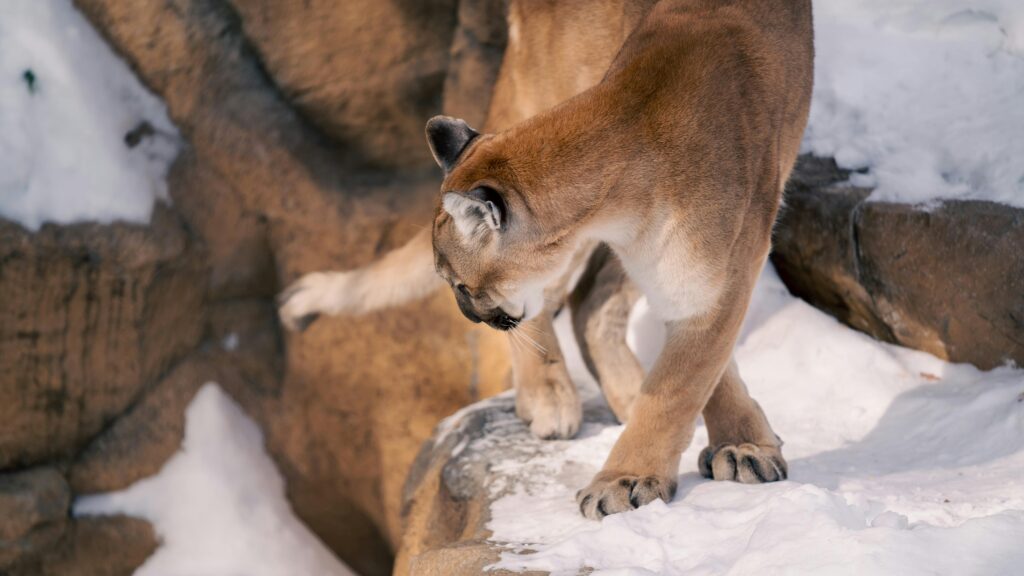Pumas, also known as cougars, mountain lions, panthers, or catamounts, are one of the most elusive and powerful predators of the Americas. Revered for their strength, agility, and adaptability, pumas are top-of-the-food-chain hunters that thrive in diverse environments, from the dense forests of Canada to the arid deserts of the southwestern United States. In this article, we’ll explore the life of the puma, from its behavior and hunting tactics to its unique role in ecosystems and the challenges it faces in the modern world.
1. Puma Species and Distribution
The puma (Puma concolor) is a member of the Felidae family and is the largest wild cat in North America. With a wide distribution, pumas are found across the Americas, from the Canadian Rockies to the tip of South America. They are highly adaptable creatures, capable of living in a range of habitats, including:
- Mountainous regions: Pumas are often associated with rugged, mountainous terrain where their excellent climbing abilities give them a strategic advantage over prey.
- Forests: They thrive in temperate forests, where the dense underbrush allows them to stalk prey with stealth.
- Desert landscapes: In the southwestern United States and Mexico, pumas are well-adapted to dry, arid environments, where they hunt deer, coyotes, and smaller mammals.
- Grasslands and savannas: Pumas are also found in open plains, where they can use their speed and stealth to ambush prey.
Although the puma’s range is vast, their presence in certain areas has diminished due to habitat loss, human encroachment, and hunting. Nonetheless, pumas remain one of the most widespread big cats in the world.
2. Physical Characteristics
Pumas are strikingly beautiful and athletic creatures, known for their powerful build and sleek, muscular bodies. Here are some of the defining physical features of a puma:
- Size: Pumas are large cats, with males weighing between 120 and 220 pounds (55-100 kg), and females slightly smaller, weighing around 64 to 141 pounds (29-64 kg). They stand about 24 to 30 inches (60-76 cm) at the shoulder and can reach up to 8 feet (2.4 meters) in length, including their tail.
- Coat: Pumas have a short, dense coat that ranges in color from tawny or grayish-brown to silvery-gray, with lighter underparts. Their fur helps them blend into their surroundings, whether they are navigating rocky terrains or dense forests. Some individuals may have a darker coat, but they are typically uniformly colored, unlike the spotted or striped patterns seen in other wild cats.
- Tail: Pumas have long, muscular tails that help them balance while running or climbing. The tail can be used for communication, signaling emotions like excitement or aggression.
- Paws and Claws: Pumas have large, padded paws and retractable claws, which are essential for climbing, hunting, and defending themselves. The claws are sharp and powerful, enabling them to grasp prey and scale trees with ease.
- Eyesight and Senses: Like most big cats, pumas have excellent night vision, which allows them to hunt during dawn, dusk, and night—when their prey is most active. Their keen sense of smell and hearing also play an important role in locating prey and detecting danger.
3. Behavior and Hunting Tactics
Pumas are solitary animals, and they exhibit behaviors typical of other big cats, such as maintaining large territories and being highly territorial. They are elusive and stealthy, often hunting alone, and they rely on ambush tactics rather than chasing down prey like cheetahs or lions.
- Territoriality: Pumas are territorial animals that mark their territories with scent markings, including urine and scratch marks on trees or rocks. Male pumas have larger territories than females, and these territories can span hundreds of square miles, depending on the availability of prey and suitable habitat.
- Hunting Techniques: As apex predators, pumas are skilled hunters with incredible strength, speed, and agility. They primarily hunt ungulates (hoofed animals) such as deer, elk, and bighorn sheep, but they will also take smaller animals like rabbits, coyotes, or even domestic livestock in some areas. Pumas are ambush predators, stalking their prey quietly and then using explosive bursts of speed to get close enough to pounce. They prefer to ambush prey from behind or above, using their excellent climbing skills to get a height advantage.
- Kill Strategy: Once a puma has ambushed its prey, it typically delivers a powerful bite to the neck or throat, aiming to crush the windpipe or sever the spinal cord. This ensures a quick, humane kill. Afterward, the puma will drag its prey to a secluded spot where it can feed in peace.
- Diet: Pumas are opportunistic eaters, meaning they will consume whatever prey is available. Although deer make up the majority of their diet, pumas will also hunt smaller mammals, and in some cases, even take on larger predators like coyotes or wild boars. They are known to scavenge from other predators if the opportunity arises, but they generally prefer fresh kills.
- Longevity: In the wild, pumas typically live for around 8 to 13 years. However, in captivity, they can live longer, sometimes reaching up to 20 years due to the absence of natural threats like predators, injury, or disease.
4. Pumas in Ecosystems
As apex predators, pumas play a vital role in maintaining the balance of their ecosystems. By controlling populations of prey species such as deer and elk, pumas prevent overgrazing of vegetation and help maintain healthy plant life. This, in turn, benefits other species that depend on the same plant resources for food and shelter.
In some areas, the reintroduction of pumas has been part of broader wildlife conservation efforts. For example, when pumas were reintroduced to places like the Great Basin in the western United States, the balance of the ecosystem shifted positively, with an increase in biodiversity and healthier populations of prey species.
5. Puma and Human Interactions
Pumas have a complex relationship with humans. Historically, pumas were seen as a threat to livestock, which led to widespread hunting and trapping. As human settlements expanded into the natural habitats of pumas, conflicts between the two became more common. Today, pumas face significant threats from habitat fragmentation, illegal hunting, and vehicle collisions. However, they are still relatively widespread in the Americas, and conservation efforts have been put in place to protect their habitats and ensure their survival.
Despite being shy and elusive by nature, pumas occasionally come into contact with humans, especially in areas where their natural habitats are being encroached upon. There are rare instances of puma attacks on humans, but these incidents are typically the result of the animal feeling threatened, cornered, or hungry, rather than a deliberate act of aggression.
In response to the growing human-puma interactions, wildlife experts emphasize the importance of puma conservationand educating the public about living safely in puma habitats. By understanding the natural behavior of pumas and respecting their space, humans can minimize the risks of conflict and help preserve this majestic species.
6. Conservation Status and Challenges
While pumas are not currently listed as endangered, they face a variety of threats to their survival, including:
- Habitat loss and fragmentation: As human development encroaches on their territories, pumas are often forced into smaller, isolated patches of wilderness. This limits their access to prey and makes it harder for them to find mates, contributing to population decline.
- Hunting and poaching: Although hunting pumas is illegal in many regions, illegal poaching still occurs, driven by the demand for their pelts and body parts. Additionally, pumas are often killed in retaliation for livestock predation.
- Vehicle collisions: As more roads are built through puma habitats, vehicle collisions have become a significant threat. Pumas often cross roads while hunting or moving between territories, putting them at risk of injury or death.
Efforts are underway to protect pumas and their habitats. Wildlife corridors—designated routes that allow animals to safely cross roads or urban areas—have been established in some regions to help reduce the risks of road fatalities. Additionally, local governments and conservation organizations are working to preserve puma habitats and mitigate human-wildlife conflict.
7. Final Thoughts
Pumas are remarkable creatures, known for their stealth, strength, and adaptability. As apex predators, they play a crucial role in maintaining the health of ecosystems, and their conservation is vital for preserving the biodiversity of the Americas. Despite the challenges they face, pumas are resilient, and efforts to protect them and their habitats are ongoing.
By understanding the natural history of pumas and supporting conservation initiatives, we can help ensure that future generations will continue to marvel at the power and grace of these magnificent animals. Whether silently stalking through the woods or resting high on a mountain cliff, the puma remains a symbol of the wild beauty and untamed spirit of the Americas.



